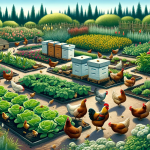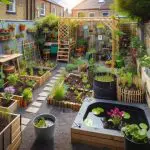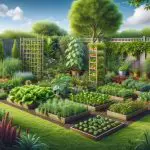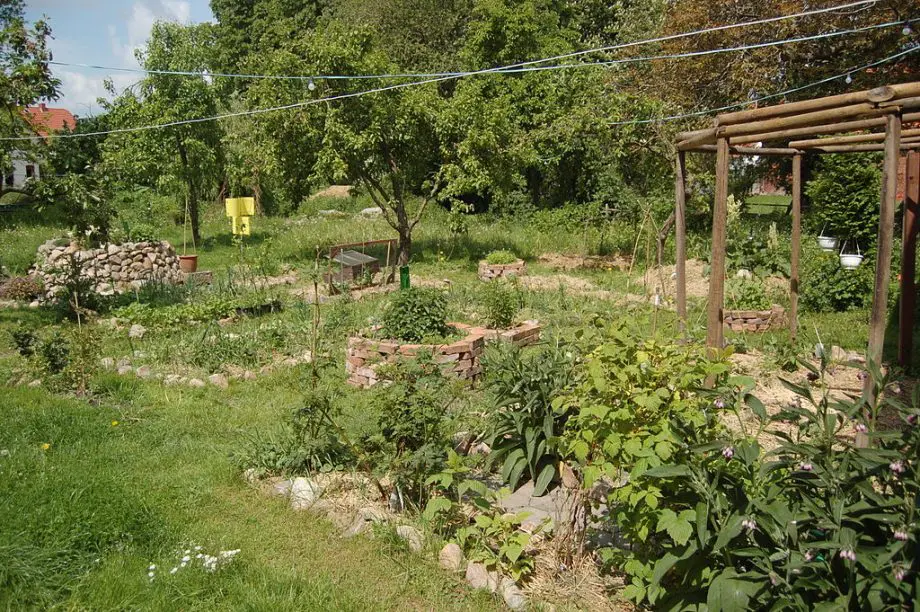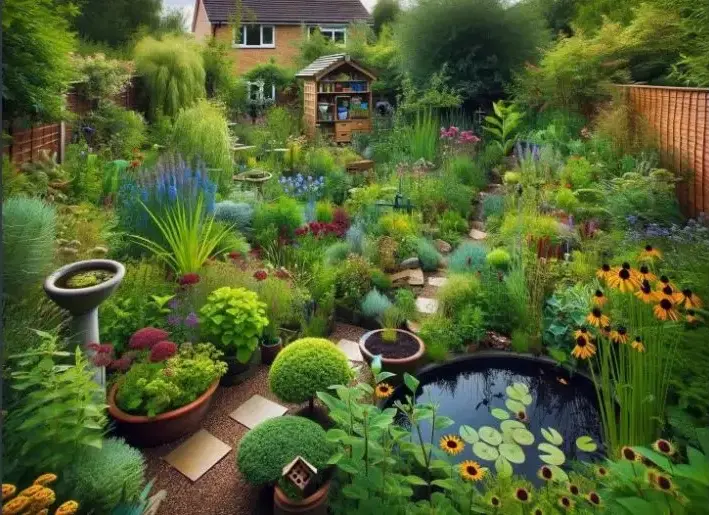
Discover transformative permaculture garden ideas for creating a sustainable oasis. Learn about eco-friendly gardening techniques adaptable to any space.
Permaculture Gardening Key Takeaways:
- Permaculture gardening emphasizes creating self-sustaining ecosystems adaptable to any space.
- These gardens follow natural patterns, enhance biodiversity, and minimize the need for external inputs, representing an eco-friendly gardening approach.
Start on a journey into the world of permaculture gardening.
This approach adapts to various spaces, from large backyards to small balconies, turning them into thriving, eco-friendly environments.
We explore innovative gardening methods that work in harmony with nature, for a more sustainable and fulfilling gardening experience.
Permaculture Garden Ideas: Sustainable Gardening at Its Best
Embark on an inspiring journey through the world of permaculture garden ideas, where sustainability meets creativity.
This section is dedicated to exploring a variety of permaculture techniques and concepts that can transform any garden space, large or small, into a thriving, eco-friendly ecosystem.
From innovative layouts and plant selections to water management and wildlife integration, these ideas are designed to inspire and guide you in creating a garden that not only looks beautiful but also contributes positively to the environment.
Whether you’re a seasoned gardener or just starting out, these permaculture ideas will provide you with the knowledge and inspiration needed to cultivate a sustainable and harmonious outdoor space.
A permaculture garden is a design that mimics nature so that you can garden organically, encourage the right wildlife and have a low-maintenance yard all in one hit. Homes and Gardens
Permaculture Garden Layout:
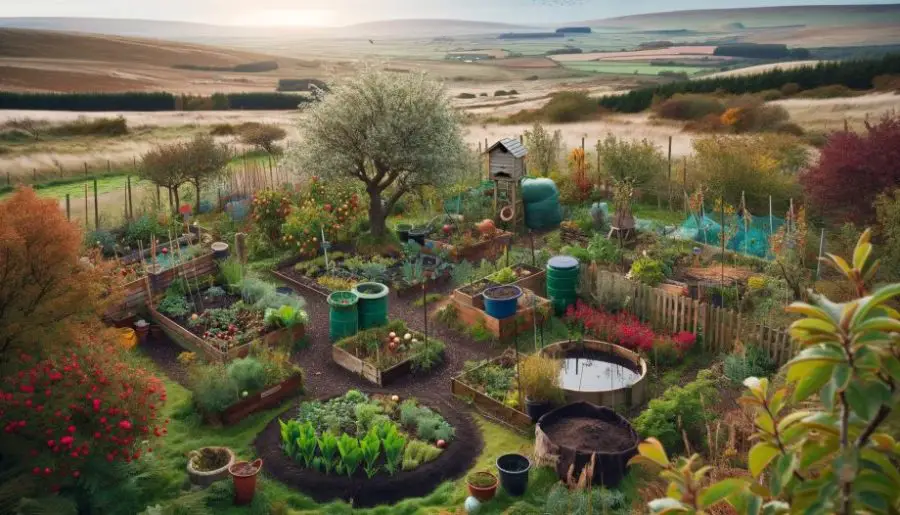
Permaculture garden layouts are essential for sustainable, efficient gardening.
This method prioritizes creating a self-sustaining ecosystem in harmony with nature.
A well-designed layout considers local climate, soil quality, and resources, transforming your garden into a productive haven.
Integrating permaculture principles into your garden design not only beautifies your outdoor space but also positively impacts the environment.
We will uncover key elements of permaculture garden layouts and their effective implementation.
Understanding Your Space:
Permaculture Gardening for the Absolute Beginner
To create a thriving permaculture garden, understanding the specific characteristics of your space is crucial.
This involves a detailed analysis of various environmental factors and the available resources. Here’s how to expand on this:
Site Analysis:
-
- Sunlight Patterns: Track the sun’s movement across your garden throughout the day. Note areas that receive full sun, partial shade, or full shade. This information is vital for choosing plants suited to each light condition.
- Wind Direction: Observe the direction and strength of prevailing winds. Wind patterns can affect plant growth, moisture retention, and temperature in your garden.
- Soil Conditions: Test your soil for pH level, texture, and nutrient content. Understanding soil type helps in selecting appropriate plants and determining if soil amendments are needed.
- Topography: Evaluate the slope and elevation variations in your garden. This affects drainage and the microclimates within your space. For instance, slopes can lead to faster water runoff, requiring specific strategies to retain moisture.
Resource Assessment:
-
- Rainwater: Assess how rainwater flows and collects in your garden. Identifying natural collection points can guide the placement of rain gardens or water catchment systems.
- Compost Materials: Look for organic waste sources like kitchen scraps, yard waste, or local community compost programs. These can be turned into valuable compost for your garden.
- Existing Vegetation: Examine the plants currently thriving in your space. They can provide clues about soil quality and microclimates. Some existing vegetation might be beneficial and can be incorporated into your permaculture design.
- Local Climate and Weather Patterns: Understanding your local climate, including seasonal temperature ranges and precipitation patterns, is essential. This influences plant selection and garden planning.
By conducting a thorough analysis of your garden’s unique characteristics and available resources, you can design a permaculture garden that is not only sustainable and productive but also harmonious with the natural environment.
This careful planning and understanding lay the foundation for a successful permaculture garden.
Design Principles for Permaculture Gardens:
In permaculture gardens, the design principles are fundamental in shaping spaces that are not only productive but also sustainable and in harmony with the natural world.
These principles guide the efficient use of resources, thoughtful placement of elements, and fostering of biodiversity, creating ecosystems that thrive with minimal intervention.
Permaculture Design: A Step-by-Step Guide
In this section, we explore key permaculture design principles, such as zoning and sector planning, efficient water use, and creating synergies between different garden components.
These concepts are essential for anyone looking to transform their garden into an eco-friendly and self-sustaining oasis, regardless of the garden’s size or location.
Zoning and Sector Planning:
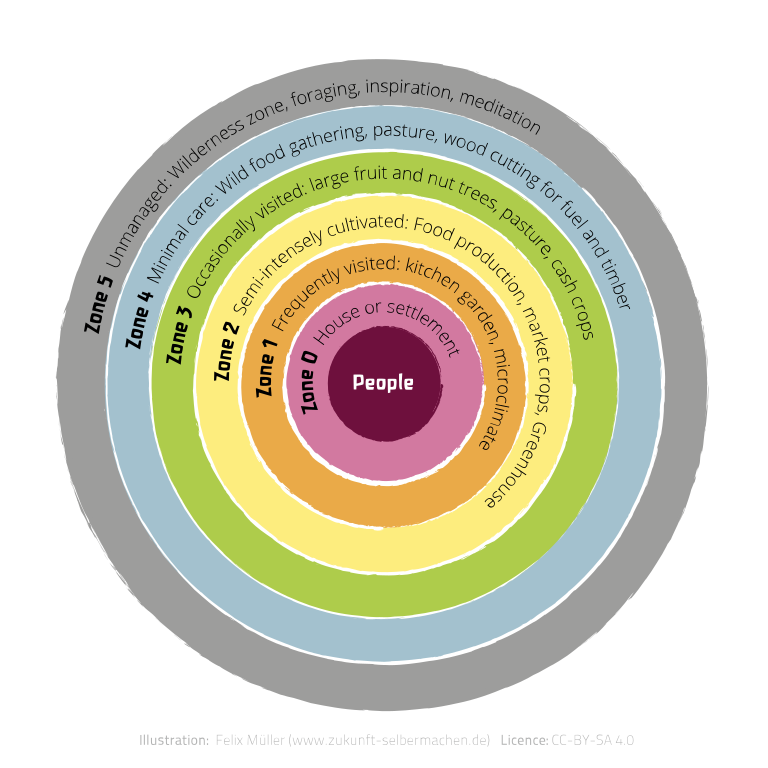
-
- Zoning Concept: Divide your garden into distinct zones based on how often you need to access or tend to different areas. For instance, Zone 1 could be areas you visit daily like herb gardens or kitchen gardens, while Zone 5 might be a wilder, self-maintaining area.
- Considerations for Placement: Place elements that require frequent care or harvesting, such as vegetable patches or salad greens, closer to your home. This reduces the time and effort needed for daily gardening tasks.
- Sector Analysis: Understand the external influences on your garden, like sun path, wind, wildlife corridors, and views. Arrange your garden sectors to maximize positive influences and minimize negative ones.
- Creating Functional Spaces: Design each zone for its specific function. For example, a greenhouse or cold frames might be closer to the house for easy access in colder months, while composting areas could be positioned further away.
Efficient Water Use:

-
- Rainwater Harvesting: Design your garden to capture and store rainwater. This can include installing rain barrels, creating a cistern system, or using rainwater for irrigation.
- Swales and Rain Gardens: Implement swales (shallow trenches) and rain gardens to capture and redirect rainwater. This not only helps with water retention in the soil but also prevents erosion and runoff.
- Irrigation Strategies: Use drip irrigation or soaker hoses for efficient water use. These methods deliver water directly to the root zone of plants, minimizing evaporation and waste.
- Mulching: Apply organic mulch around plants to reduce water evaporation from the soil, regulate soil temperature, and add organic matter to the soil as it decomposes.
- Plant Selection: Choose plants that are suited to your area’s rainfall patterns and soil moisture levels. Drought-tolerant plants can be a good choice for areas with less rainfall.
- Water-Smart Garden Layout: Design your garden layout to take advantage of natural slopes for water movement, and consider grouping plants with similar water needs together to make watering more efficient.
By meticulously planning and organizing your garden with these principles, you create a more efficient, productive, and sustainable permaculture environment.
This not only benefits your plants and reduces workload but also conserves resources and supports the overall health of the ecosystem.
Creating Microclimates:
Creating microclimates within your garden is a pivotal aspect of permaculture, offering an innovative way to enhance the productivity and health of your space.
By carefully manipulating elements like shade, windbreaks, and plant diversity, you can create small, specialized areas within your garden that cater to the unique needs of different plants.
This approach not only optimizes growing conditions but also encourages a rich, diverse ecosystem.
In this section, we’ll explore various strategies to develop these microclimates, from using natural elements for protection to diversifying plant life.
Whether you have a sprawling garden or a modest backyard, understanding and implementing microclimate techniques can significantly boost your garden’s resilience and yield.
Shade and Windbreaks:
-
- Strategic Planting for Shade: Utilize larger trees and tall shrubs to create shaded areas, which can protect more sensitive plants from intense sunlight. This can be especially beneficial in hot climates where excessive sun can stress plants.
- Types of Shade: Consider different types of shade, such as dappled shade under deciduous trees or dense shade under evergreens, and choose plants suited to each type.
- Windbreaks: Plant trees and shrubs in a way that they act as natural wind barriers. This can protect your garden from strong winds, which can dry out soil and damage or stress plants.
- Layering for Protection: Use a layering approach, with taller plants providing shelter for understory plants. This mimics natural forest conditions and creates a more resilient ecosystem.
Plant Diversity:
-
- Variety of Species: Incorporate a wide range of plant species with different heights, growth habits, and root systems.
- This diversity creates various microclimates and habitats within your garden.
Beneficial Combinations:
Here is more about plant combinations that benefit each other come within the context of creating microclimates in a permaculture garden:
- Companion Planting: Utilize companion planting strategies where certain plant combinations support each other’s growth. For example, tall sunflowers can provide shade for lower-growing, shade-tolerant plants. Marigolds, when planted near vegetables, can deter pests with their strong scent.
- Nitrogen Fixers: Include plants like legumes (beans, peas) that fix nitrogen in the soil, benefiting neighboring plants. These can be interplanted with nitrogen-hungry species, improving soil fertility without chemical fertilizers.
- Pest Control: Plant herbs and flowers that naturally repel pests or attract beneficial insects. For example, planting basil near tomatoes can help repel flies and mosquitoes, while lavender can attract pollinators and beneficial insects.
- Ground Cover Plants: Utilize ground cover plants to maintain soil moisture and prevent weeds. For example, planting clover or creeping thyme can provide these benefits while also adding aesthetic value.
- Polycultures: Create polycultures by mixing different types of plants together. This can reduce the spread of pests and diseases, as they often prefer monocultures. It also leads to more efficient use of space and resources.
- Vertical Layering: Implement vertical layering by combining tall plants, mid-height shrubs, and ground covers. This creates a diverse habitat and microclimate, making the most of vertical space.
- Microclimate Buffering: Some plants can buffer the microclimate for others. For instance, a row of hardy shrubs can protect more delicate plants from harsh winds, creating a more hospitable microclimate behind them.
Incorporating these beneficial combinations not only enhances the health and productivity of a permaculture garden but also contributes to the creation of diverse and resilient microclimates.
This approach leads to a more balanced and self-sustaining ecosystem within the garden.
Maximizing Space:
Maximizing space effectively is a cornerstone of permaculture gardening, especially crucial for those working with limited areas.
By innovatively using every inch of available space, you can transform even the smallest garden or balcony into a lush, productive haven.
In this section, we delve into practical and creative strategies like vertical gardening, layering, and companion planting.
These techniques not only enhance the efficiency of your garden but also add aesthetic value and diversity.
Whether you’re cultivating a tiny urban balcony or a compact backyard, these space-maximizing ideas will empower you to create a thriving permaculture garden, rich in variety and sustainability.
Vertical Gardening:
-
- Trellises and Arbors: Utilize trellises, arbors, and other vertical structures to grow climbing plants like beans, peas, and vining flowers. This not only saves ground space but also adds an aesthetic dimension to the garden.
- Wall Planters: Attach planters to walls or fences to grow herbs, small vegetables, and flowers. This is particularly effective in urban settings where ground space is limited.
- Hanging Baskets: Use hanging baskets for plants like strawberries, cherry tomatoes, and trailing flowers. They are ideal for balconies and patios, making use of overhead space.
- Vertical Pallet Gardens: Recycle wooden pallets into vertical planters for small, shallow-rooted plants. This approach is both space-efficient and eco-friendly.
Layering and Companion Planting:
-
- Canopy Layer: Start with taller trees or shrubs as the canopy layer. This layer provides shade and creates a microclimate for the layers below.
- Understory Layer: Beneath the canopy, plant shrubs or taller perennials. This layer benefits from the moderated light and wind conditions created by the canopy.
- Herbaceous Layer: Include a variety of herbs and flowering plants that thrive in the conditions created by the upper layers. These plants can attract beneficial insects and improve soil health.
- Ground Cover Layer: Utilize low-growing plants to cover the soil, helping to retain moisture, suppress weeds, and prevent soil erosion.
- Companion Planting Benefits: Carefully select plant combinations that benefit each other. For example, planting garlic near roses can help deter pests, and growing carrots and onions together can mutually protect against certain pests.
- Root Diversity: Incorporate plants with different root depths to maximize nutrient uptake from different soil layers and reduce competition for resources.
- Microclimate Optimization: Use companion planting to create favorable microclimates. For instance, taller plants can provide necessary shade for more sensitive, lower-growing plants.
By effectively employing vertical gardening and layered planting with companion plants, even the smallest gardens can become highly productive and diverse.
This approach not only maximizes the use of available space but also creates a more dynamic and interactive garden ecosystem.
Integrating Wildlife:
Integrating wildlife into your permaculture garden is more than just a method to enhance its beauty; it’s a vital step towards creating a balanced and sustainable ecosystem.
In this section, we’ll explore how attracting beneficial insects, birds, and other wildlife can enrich your garden’s health and resilience.
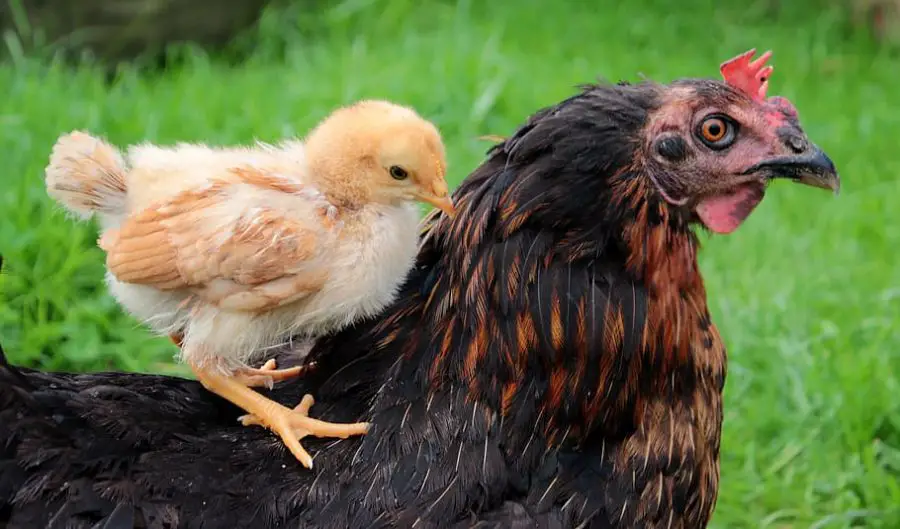
From planting native flora to constructing habitats like bee hotels and bird baths, each element plays a significant role in nurturing biodiversity.
Embracing these practices not only supports local wildlife but also contributes to natural pest control and pollination, creating a harmonious and thriving garden environment for all its inhabitants.
Attracting Beneficial Insects:
-
- Native Plant Selection: Choose native plants that are particularly attractive to local pollinators, like bees, butterflies, and beneficial wasps. Native plants are adapted to local insect populations and often require less maintenance.
- Diverse Flowering Plants: Incorporate a variety of flowering plants that bloom at different times throughout the year. This provides a continuous food source for pollinators.
- Insectary Plants: Include plants specifically known for attracting beneficial insects. For instance, plants like yarrow, dill, and fennel are great for attracting ladybugs, which help control aphids.
- Avoiding Pesticides: Refrain from using chemical pesticides, as they can harm beneficial insects. Opt for natural pest control methods to maintain a healthy insect population.
Creating Habitats for Wildlife:
-
- Bird Baths and Water Features: Install bird baths or small water features, which not only attract birds but also provide water for insects and other small wildlife. Ensure to keep the water clean and replenish it regularly.
- Bee Hotels: Create or install bee hotels to provide nesting sites for solitary bees. These bees are excellent pollinators and play a crucial role in the ecosystem.
- Log Piles and Brush Shelters: Leave piles of logs or brush in a quiet corner of your garden. These provide habitats for a variety of creatures, such as beetles, frogs, and small mammals, which contribute to a balanced ecosystem.
- Wildflower Meadows: If space allows, designate an area as a wildflower meadow. This not only adds beauty to your garden but also offers a habitat for wildlife.
- Hedge Borders: Plant hedges instead of building fences. Hedges provide shelter and nesting sites for birds and small mammals.
- No-Disturbance Zones: Allocate areas in your garden where you allow nature to take its course. These undisturbed spaces can become safe havens for wildlife.
- Plant Layer Diversity: Maintain a variety of plant layers (canopy, shrubs, ground cover) to cater to different species of birds and insects.
By integrating these elements into a permaculture garden, you not only enhance the biodiversity of your space but also contribute to a healthier, more sustainable ecosystem.
These practices create a garden that is not just productive for human use but also a thriving habitat for local wildlife.
Permaculture Garden Ideas Key Takeaways:
- Benefits of Permaculture: Highlights eco-friendly, low-maintenance gardening.
- Innovative Designs: Focuses on companion planting and native species.
- Sustainability and Maintenance: Emphasizes natural ecosystems for simpler upkeep.
Understanding Permaculture Concepts:
Permaculture: A Designers’ Manual
Permaculture is a sustainable gardening approach aligning with natural ecosystems.
We delve into its essence and foundational principles, guiding gardeners toward an eco-friendly and mindful cultivation practice.
What is a Permaculture Garden?
Permaculture gardens are grounded in sustainable, self-sufficient ecosystems. They emphasize diversity, mimic nature, and prioritize long-term environmental health.
By integrating flora, fauna, and natural elements, these gardens create harmonious environments beneficial for nature and gardeners.
Core Principles of Permaculture:
Central to permaculture are principles focusing on earth care, waste minimization, and mutually beneficial relationships between gardeners and the environment.
These principles foster respect for natural resources, supporting a sustainable lifestyle beneficial to both land and its inhabitants.
Permaculture Garden Design:
Gaia’s Garden: A Guide to Home-Scale Permaculture
Designing a permaculture garden goes beyond planting. It’s about crafting an ecosystem where elements synergize. This segment explores plant selection and garden space design, aligning with permaculture’s sustainable ethos.
Selecting Plants for Permaculture:
Choosing appropriate plants is vital. Opt for native species and companion planting to bolster overall garden health.
This method promotes mutual plant support, reduces artificial fertilizers and pesticides, and enhances biodiversity.
Designing Your Garden Space:
Permaculture garden design considers your space’s natural traits. Understand sunlight, shade, wind, and water patterns.
Mimicking natural systems, grouping similar-need plants, and leveraging landscape features fosters a thriving ecosystem.
Implementing Permaculture in Various Spaces:
Permaculture adapts to space and location. We offer practical solutions for urban gardeners and those in diverse climates, demonstrating permaculture’s versatility.
Permaculture for Small Spaces:
Urban permaculture maximizes limited areas with vertical, container, and rooftop gardens. It shows permaculture’s feasibility in constrained spaces, affirming that sustainable gardening fits any setting.
Permaculture in Different Climates:
Permaculture suits various climates, from arid to temperate. The key lies in selecting climate-appropriate plants and designing to leverage natural climate benefits, ensuring a flourishing garden in any environment.
Key Elements in Garden Planning:
Understanding soil and water is crucial in permaculture. We provide insights into best practices for soil preparation and efficient water management, critical for a productive permaculture garden.
Soil Preparation and Health:
Healthy soil, rich in organic matter, is a cornerstone of permaculture. Techniques like composting, no-dig gardening, and natural soil amendments enhance fertility, supporting a vibrant, self-sustaining ecosystem.
Caring for and adding to the soil is perhaps the simplest and most profound piece of gardening advice I can give, and for me, as with many other practitioners, this is rooted in the implication of no-till and/or one-dig garden beds. Sheet mulching is perhaps the easiest and fastest route to get there, especially for people who already have an abundance of garden supplies. Permaculture News
Water Management:
Efficient water management in permaculture includes capturing rainwater, using mulch to maintain moisture, and implementing irrigation systems like drip irrigation.
These practices ensure effective water use, reducing reliance on external sources, and maintaining a balanced garden ecosystem.
Creative Permaculture Ideas:
Permaculture blends functionality with creativity and innovation. Using unique gardening techniques and ideas, such as accessibility considerations and the lasagna gardening method, add diversity and ease to the permaculture garden.
Accessibility in Permaculture:
Incorporating raised beds and container gardens enhances accessibility, making gardening more approachable for individuals with mobility issues.
These methods also provide better soil quality control and easier maintenance.
Lasagna Gardening Technique:
Lasagna gardening is a no-till, layering method for creating fertile soil with minimal effort.
It involves layering organic materials, which decompose to form nutrient-rich soil, ideal for a permaculture garden.
Advanced Techniques for Backyards:
Advanced permaculture techniques elevate your garden with sophisticated sustainability and self-sufficiency methods.
This section covers designing a permaculture backyard and the importance of a closed-loop system with no waste.
Designing a Backyard Permaculture Garden:
Planning and observation are key in creating a backyard permaculture garden.
Understand your land’s dynamics and integrate them into your design for a productive, sustainable space.
Resource Efficiency and Zero Waste:
Permaculture aims for a closed-loop system, minimizing waste. This includes composting organic waste, using renewable resources, and designing the garden to become a self-sustaining ecosystem.
FAQs
In our FAQs section, we address a wide range of commonly asked questions about permaculture gardening.
This informative segment is designed to provide valuable insights and practical advice for both beginners and seasoned gardeners.
Whether you’re curious about the basics of permaculture, seeking tips for implementing these principles in various settings or looking to deepen your understanding of sustainable gardening practices, you’ll find answers here.
This section aims to demystify permaculture and empower gardeners of all levels to create more productive, eco-friendly, and self-sustaining gardens.
Q: What is Permaculture Gardening?
A: Permaculture gardening is a sustainable approach to landscaping that works in harmony with nature.
It’s about creating a self-sufficient ecosystem emphasizing biodiversity, soil health, and resource conservation.
This method integrates plants, animals, and natural elements to develop a productive and balanced environment.
Q: How Can I Start a Permaculture Garden in a Small Urban Space?
A: Starting a permaculture garden in a small urban space involves maximizing vertical space, using container gardening, and selecting plants suited to your specific microclimate.
Utilize balconies, rooftops, and even window sills. Focus on companion planting and efficient water use to make the most of limited space.
Q: Can Permaculture Techniques Improve My Garden’s Sustainability?
A: Yes, permaculture techniques can significantly improve your garden’s sustainability. By mimicking natural ecosystems, using local resources wisely, and promoting biodiversity, permaculture gardens require fewer external inputs and create less waste, thereby enhancing sustainability.
Q: What Are the Key Principles of Permaculture Design?
A: The key principles of permaculture design include observing and interacting with nature, catching and storing energy, obtaining a yield, applying self-regulation, using and valuing renewable resources, producing no waste, designing from patterns to details, integrating rather than segregating, using small and slow solutions, using and valuing diversity, using edges and valuing the marginal, and creatively using and responding to change.
Q: How Does Permaculture Benefit Local Wildlife and Biodiversity?
A: Permaculture benefits local wildlife and biodiversity by creating habitats that support various species.
Incorporating native plants, water features, and organic practices attracts beneficial insects, birds, and other wildlife, enhancing the ecological balance and health of the garden and surrounding areas.
Q: How Can I Implement Water-Saving Techniques in My Permaculture Garden?
A: Implement water-saving techniques by using drip irrigation, rainwater harvesting systems, mulching, and planting drought-resistant species.
Design your garden layout to optimize water use and retention, such as through the creation of swales and rain gardens.
Q: What Role Do Companion Plants Play in Permaculture?
A: Companion plants play a crucial role in permaculture by enhancing soil health, deterring pests, attracting beneficial insects, and improving plant growth.
They create symbiotic relationships, where plants support each other’s needs, leading to a more resilient garden ecosystem.
Q: Why Permaculture?
Permaculture promotes natural growing systems, organic living, and environmental balance.
It educates on local bioregions, weather, and fertility, helping reduce stress, consumption, waste, and pollution.
Q: What is Permaculture Gardening?
A: Permaculture gardening is a sustainable approach to landscaping that works in harmony with nature.
It’s about creating a self-sufficient ecosystem emphasizing biodiversity, soil health, and resource conservation.
This method integrates plants, animals, and natural elements to develop a productive and balanced environment.
Q: How Can I Start a Permaculture Garden in a Small Urban Space?
A: Starting a permaculture garden in a small urban space involves maximizing vertical space, using container gardening, and selecting plants suited to your specific microclimate.
Utilize balconies, rooftops, and even window sills. Focus on companion planting and efficient water use to make the most of limited space.
Q: Can Permaculture Techniques Improve My Garden’s Sustainability?
A: Yes, permaculture techniques can significantly improve your garden’s sustainability.
By mimicking natural ecosystems, using local resources wisely, and promoting biodiversity, permaculture gardens require fewer external inputs and create less waste, thereby enhancing sustainability.
Q: What Are the Key Principles of Permaculture Design?
A: The key principles of permaculture design include observing and interacting with nature, catching and storing energy, obtaining a yield, applying self-regulation, using and valuing renewable resources, producing no waste, designing from patterns to details, integrating rather than segregating, using small and slow solutions, using and valuing diversity, using edges and valuing the marginal, and creatively using and responding to change.
Q: How Does Permaculture Benefit Local Wildlife and Biodiversity?
A: Permaculture benefits local wildlife and biodiversity by creating habitats that support various species. Incorporating native plants, water features, and organic practices attracts beneficial insects, birds, and other wildlife, enhancing the ecological balance and health of the garden and surrounding areas.
Q: How Can I Implement Water-Saving Techniques in My Permaculture Garden?
A: Implement water-saving techniques by using drip irrigation, rainwater harvesting systems, mulching, and planting drought-resistant species.
Design your garden layout to optimize water use and retention, such as through the creation of swales and rain gardens.
Q: What Role Do Companion Plants Play in Permaculture?
A: Companion plants play a crucial role in permaculture by enhancing soil health, deterring pests, attracting beneficial insects, and improving plant growth.
They create symbiotic relationships, where plants support each other’s needs, leading to a more resilient garden ecosystem.
Q: How Does Permaculture Differ from Conventional Agriculture?
A: Permaculture differs from conventional agriculture in its approach to land use and resource management.
It emphasizes sustainable, ecological practices that work in harmony with nature, focusing on biodiversity, soil health, and resource conservation, in contrast to the often more resource-intensive and monoculture-based methods of conventional agriculture.
Q: Can Permaculture Be Practiced in Urban Areas?
A: Yes, permaculture can be effectively practiced in urban areas.
Techniques such as rooftop gardening, vertical gardening, and container gardening allow urban dwellers to create productive, sustainable gardens in small spaces, contributing to local food production and green spaces in the city.
Q: How Can Permaculture Contribute to Food Security?
A: Permaculture contributes to food security by promoting sustainable, local food systems that are resilient to climate and environmental changes.
Its principles of diversity, soil health, and efficient resource use ensure a steady, sustainable supply of food, reducing dependence on large-scale, commercial agriculture.
Q: How Does Permaculture Help in Combatting Climate Change?
A: Permaculture helps combat climate change by promoting practices that reduce carbon emissions and enhance carbon sequestration.
Sustainable land management, the use of renewable resources, and the reduction of waste and chemical inputs contribute to lowering the overall carbon footprint of agricultural practices.
Permaculture designs ecosystems that mimic natural patterns, enhancing biodiversity.
It utilizes polyculture and native species to support diverse plants, animals, and microorganisms, boosting ecosystem resilience.
Conclusion: A Sustainable Future with Permaculture Gardening
As we conclude our exploration of permaculture gardening, it’s clear that this approach is more than just a gardening technique; it’s a pathway toward a sustainable and harmonious future.
Embracing permaculture principles in our gardens and communities leads to healthier ecosystems, promotes biodiversity, and contributes to a more resilient environment.
In this final section, we reflect on the transformative power of permaculture, how it redefines our interaction with nature, and its role in shaping a greener, more sustainable world.
Whether in urban settings or rural expanses, permaculture offers practical and effective solutions for environmental challenges, encouraging us all to be stewards of the Earth.
Embracing Permaculture:
Permaculture is more than gardening; it’s a path to sustainable living and environmental stewardship. This approach integrates ecological principles, creating productive, environmentally conscious systems.
Adaptability and Accessibility:
Permaculture’s adaptable nature makes it accessible to all, encouraging urban and rural gardening. Its practices help combat climate change, enhance food security, and promote biodiversity.
A Call to Action:
The growing permaculture movement invites individuals to actively participate in creating a sustainable, regenerative future. This holistic approach to gardening fosters a deeper connection with the environment, encouraging a greener planet.






